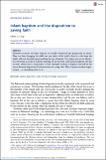Files in this item
Infant baptism and the disposition to saving faith
Item metadata
| dc.contributor.author | Crisp, Oliver D. | |
| dc.date.accessioned | 2022-10-25T11:30:02Z | |
| dc.date.available | 2022-10-25T11:30:02Z | |
| dc.date.issued | 2022-10-14 | |
| dc.identifier | 280993253 | |
| dc.identifier | 41044fba-ba89-446e-b29a-1d1d0926ecfe | |
| dc.identifier | 000867639300008 | |
| dc.identifier | 85142071657 | |
| dc.identifier.citation | Crisp , O D 2022 , ' Infant baptism and the disposition to saving faith ' , Scottish Journal of Theology , vol. 75 , no. 4 , pp. 363-373 . https://doi.org/10.1017/S0036930622000631 | en |
| dc.identifier.issn | 0036-9306 | |
| dc.identifier.other | ORCID: /0000-0001-8866-1548/work/121753957 | |
| dc.identifier.uri | https://hdl.handle.net/10023/26240 | |
| dc.description | The research that went into the composition of this article was made possible through the support of a grant from the John Templeton Foundation. | en |
| dc.description.abstract | Reformed accounts of infant baptism are usually covenantal and promissory in nature. They are about bringing the child into the ambit of the visible church in the hope the infant will own the faith upon reaching the age of reason. This paper sets out an alternative Reformed account of baptism, drawing on the Scottish confessional tradition. On this account, infants have a disposition to faith conveyed to them in baptism that will in due course become dispositional faith exercised in saving faith. Thus, baptism involves regeneration – or something close to it. | |
| dc.format.extent | 11 | |
| dc.format.extent | 216521 | |
| dc.language.iso | eng | |
| dc.relation.ispartof | Scottish Journal of Theology | en |
| dc.subject | Baptism | en |
| dc.subject | Disposition | en |
| dc.subject | Faith | en |
| dc.subject | Reformed theology | en |
| dc.subject | Regeneration | en |
| dc.subject | BR Christianity | en |
| dc.subject | T-NDAS | en |
| dc.subject.lcc | BR | en |
| dc.title | Infant baptism and the disposition to saving faith | en |
| dc.type | Journal article | en |
| dc.contributor.institution | University of St Andrews. School of Divinity | en |
| dc.identifier.doi | https://doi.org/10.1017/S0036930622000631 | |
| dc.description.status | Peer reviewed | en |
This item appears in the following Collection(s)
Items in the St Andrews Research Repository are protected by copyright, with all rights reserved, unless otherwise indicated.

